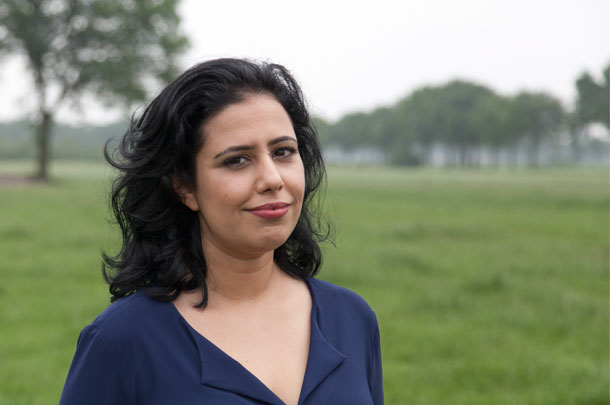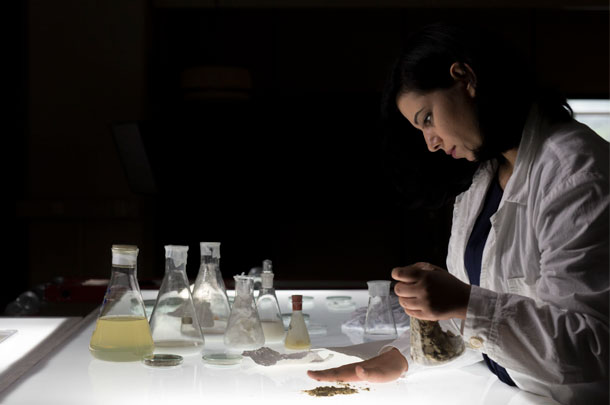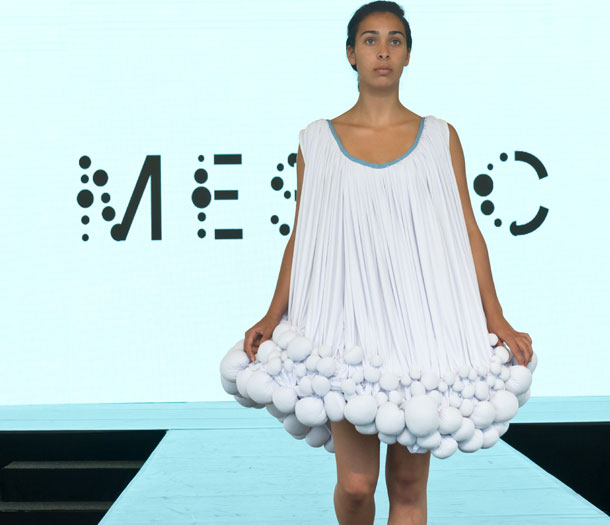Fashion and farming are rarely two words that are linked together, but when you throw manure in the mix (literally), you have a recipe for something far from conventional. And conventional is hardly a word that would describe entrepreneur and artist Jalila Essaïdi and her work.
This Dutch artist was challenged by policy makers in her country to solve the “poop problem” emanating from their well-established dairy industry. Her answer was Mestic – a bioplastic fabric made from cow manure. It’s a far cry from the conventional solutions to dealing with dairy manure, and the results are fashionably fabulous.
Essaïdi explains, “Cow manure is seen as a waste product; however, there is enough raw material locked away in this waste stream to supply multiple industries potential new biomaterials. With the method that I developed, we can turn this waste into a sustainable source for valuable products, such as beautiful textiles.”

Developing beautiful textiles was exactly what she did. In 2016, she rolled out the concept in a fashion show that received worldwide praise. Later that year, she was awarded the Global Change Award from the H&M Foundation for her innovative fabric.
When questioned about the future of Mestic, her reply was unquestionably optimistic: “The future of Mestic, or at least one of the many possibilities, is to create a society that realizes that the concept of "waste" is conceived by people. Nature does not operate on such an assumption; there is no waste as everything is [re]used. And of course we would like to create a society that proudly wears manure-based textiles!”
A poop problem
The conventional method of manure disposal, using manure as fertilizer, has created quite a problem in the Netherlands, as there is simply not enough farm ground to distribute the fertilizer. Farmers are actually charged 18 euro (about $20) per cubic meter of manure for disposal. With dairy cows producing upwards of 125 pounds of manure a day, it was creating a financial burden on farmers. The public perception of dairy farms was also creating bureaucratic pressures.
When Essaïdi approached farmers about her idea, their reaction was far from the expected ridicule, it was hopeful. She says there had been a few collective attempts by farmers to solve the problem, like the use of methane digesters, but they were met with limited success. She goes on to say, “Their reaction to the successful results from Mestic is at first one of disbelief, because they didn’t think the value would express itself in either plastics or fabrics.”
She is working with the Southern Agriculture and Horticulture Organization in the Netherlands with a focus specifically on dairy farmers. They were chosen because dairy cattle produce manure with the highest cellulose content – the basis of the bioplastic fabric and, not surprisingly, the basis of nearly all natural fiber we use in clothing like cotton or linen.

Good for agriculture
Essaïdi created a dual mission with her product. “My approach tackles two sides of the environmental issue. Not only is manure used to manufacture new products, but there is also less need to use other natural resources – trees, corn, cotton, oil – to create these products,” she says.
While her main goal may be solving environmental problems, she is also helping solve another problem: the breakdown of the agriculture sector from government regulation and even public opinion. By creating a positive outlet for a major problem in animal agriculture, she is empowering farmers. A country like the Netherlands can “keep their cows” and the economic advantage of milk production while providing the manufacturing industry with a valuable asset from a sustainable source. This solution, while in its infancy, is a positive mark on the chalkboard for agriculture.

A future in manure
Scaling production is Essaïdi’s next goal for Mestic, but it has not come without challenges. Not surprisingly, the differences in the manure are as varied as the feed the cows eat. Currently they are operating on a laboratory scale and working with 12 different farmers to sample differences between feed material, bedding and the general quality of the manure.
Once the quality can be established, then the quantity begins to matter. She says, “We are working towards an operational environment capable of processing 1,000 tons of manure into materials that are ready for market. From there, the technology is scalable; we aim for processing plants capable of processing 100,000 tons of manure per year. In the province of Noord-Brabant, the Netherlands, alone, there is enough excess manure to operate 10 of these plants.”
Watch the video below, in which Jalila Essaïdi explains the process of turning manure into products such as plastic, cardboard and textiles.
Is there a future for Mestic in the U.S.? Essaïdi’s answer is diplomatic but still enthusiastic. She says, “Once we’ve proven the scalability of the method, the future is manure refineries all over the world. From then on, every country that uses intensive farming will have its own source of raw materials for the manufacturing industry.”
Now, the question you have all been wondering: Where did Essaïdi get the name Mestic? Just like the product, she got it from the manure. The Dutch word for manure is mest. ![]()
Erica Louder is a freelance writer based in Idaho.
PHOTO 1: Since cellulose, which is the fiber found in manure, is also the basis of nearly all natural fiber like cotton or linen, it can be turned into fabric. Photo by Mike Roelofs.
PHOTO 2: Entrepreneur and artist, Jalila Essaïdi, is changing the political and public views of manure in Europe. Photo by Cleo Goossens.
PHOTO 3: Jalila Essaïdi uses the cellulose found in dairy manure to create a bioplastic fabric. Photo by Mike Roelofs.
PHOTO 4: A line of clothing made from Mestic – a bioplastic fabric made from cow manure – debuted at a European fashion show in 2016. Photo by Ruud Balk.


.jpg?t=1687979285&width=640)



